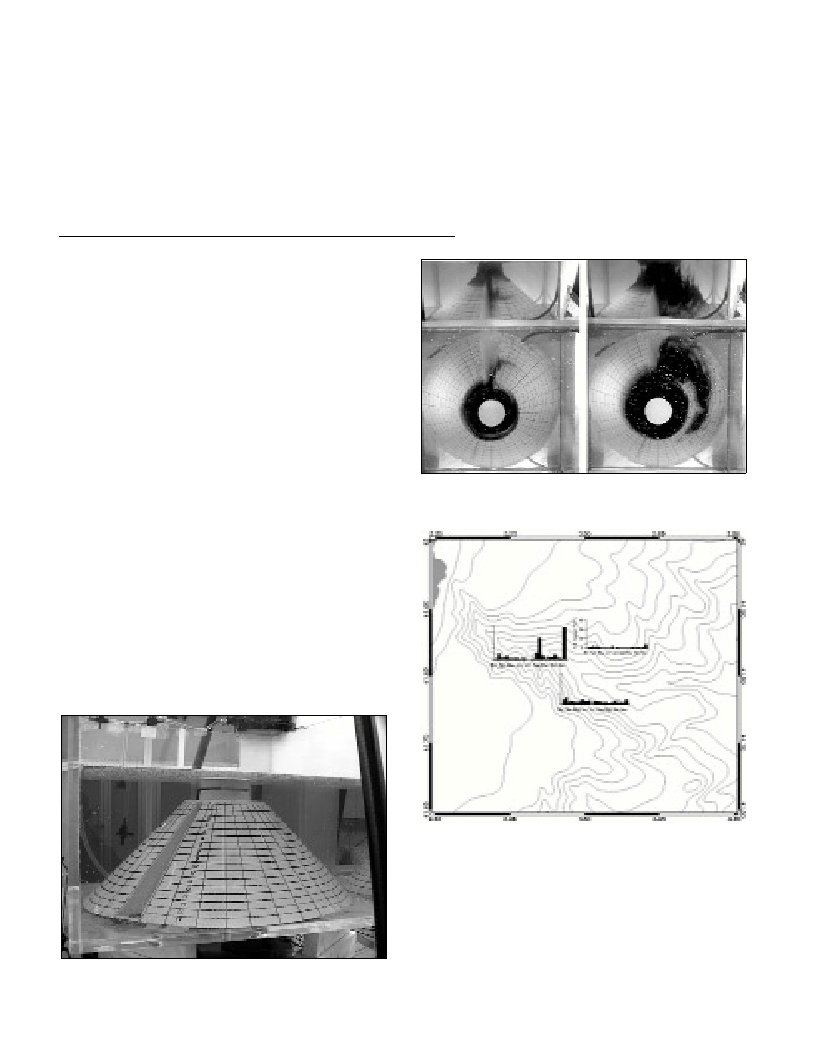Rapp. Comm. int. Mer Médit., 37,2004
102
SHELF/SLOPE EXCHANGES AND SUBMARINE CANYONS: LABORATORY MODELLING
B. Gomez
1
, S. Kremenetskiy
2
, J. Martín
1
, O. Stroganov
2
, E. García-Ladona
1*
, A. Zatsepin
2
, A. Palanques
1
,
M. Emelianov
1
, P. Puig
1
, J. Guillen and J. L. Pelegrí
1
1
Institut de Ciències del Mar, (CMIMA-CSIC), Barcelona, Spain
-
* emilio@icm.cs
2
Shirshov Institute of Okeanolokyia, RAS, Moscou, Russia
Abstract
Preliminary laboratory experiments on the interaction of a coastal current and a submarine canyon using a rotating platform are presented.
The in?uence of canyon on the behaviour of frontal current and the associated exchange processes between the shallow and deep parts of
the basin are analyzed under quasi barotropic conditions. A strong in?uence of the canyon on the dynamics of the frontal current is clearly
observed, mainly due to a downslope ?ow through the near bottom viscous layer. Comparison with recent field observations are presented.
Keywords: Submarine canyons, shelf/slope exchanges, laboratory experiments.
The continental slope is characterized by a very specific dynamics
of the water ?ows and could be considered as a frontal zone of
potential vorticity due to the rapid change of the depth with off-shore
distance. The variability and structure of the circulation within the
canyons themselves depend on various forcing factors bringing
alterations in planktonic communities and in matter transfers between
the shelf open ocean zones.
An experimental device to analyze the interaction of a coastal
current with a submarine canyon incinsing the bottom slope has been
designed [1]. The device was composed of tank of water over a
rotating platform containning a cone to simulate the sloping bottom
and including a canyon. A coastal current was obtained releasing
lighter colored fluid trhough a source in the cone vertex
axisymmetrically positioned. Two sets of experimental runs with
similars basic parameters but with and without the presence of a
submarine canyo were provided. In both cases an axisymmetric
anticyclonic frontal current was initially forme. After a while, its
width increased and then a near bottom viscous layer downslope ?ow
was formed at the front of the anticyclonic current while the position
of the front remained stationary. When the canyon is present a
considerable part of the downslope ?ow as well as the frontal current
were trapped by the canyon at its downstream wall (Fig. 2 a,b). Both
up and down canyon currents have been also observed and the
downward ?ow at the downstream wall was responsible for the major
?uid exchange from the quasi-axisymmetric frontal current (Fig. 2b).
This ?uid was transported much below of the outer edge of the frontal
current until a depth level where it continued to ?ow along the slope
downstrean the canyon.
An interesting consequence of the above results is the strong
downslope ?ow near the bottom boundary layer inside the canyon and
their implications on shelf/slope mass transfer. These results could
explain the internal structure of particulate ?uxes observed in a field
experiment carried out in the Palamós canyon (Northwest
Mediterranean), in which nera-bottom particulate were higher at the
head of the canyon and in the downstream wall than in the upstream
wall (Fig. 3).
Fig. 1. Laboratory set up to study the interaction of a coastal current and
a submarine canyon.
Fig. 2. Experiments for the quasi barotropic case including tha canyon at
two different times.
Fig. 3. Particulate ?uxes near the bottom at three locations in the
Palamós canyon during the field experiments.
References
1-Didkovskii, V., A. Semenov, A. Zatsepin (2000). Mesoscale currents
upon the smooth sloping bottom and in the presence of ridges and
canyons. In: Oceanic Fronts and Related Phenomena Konstantin Fedorov
International Memorial Symposium, IOC, Workshop Rep., 159: 89-94.

